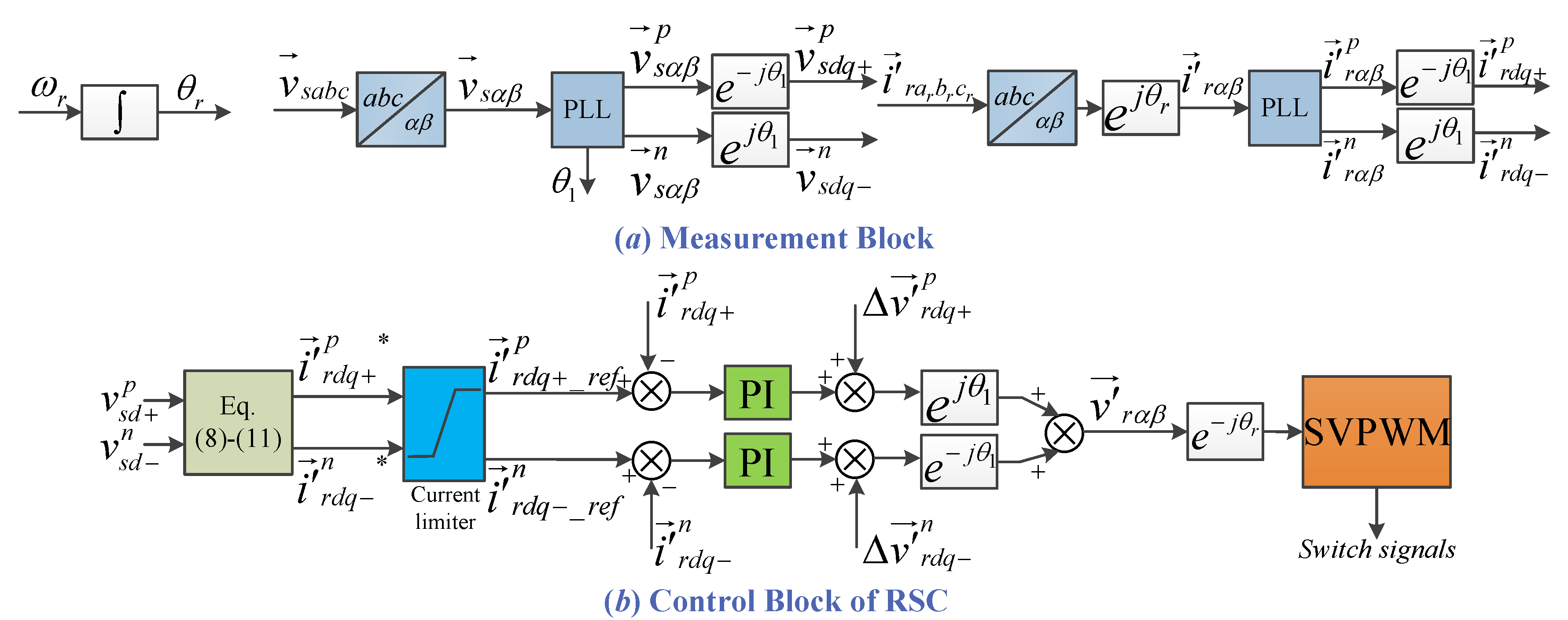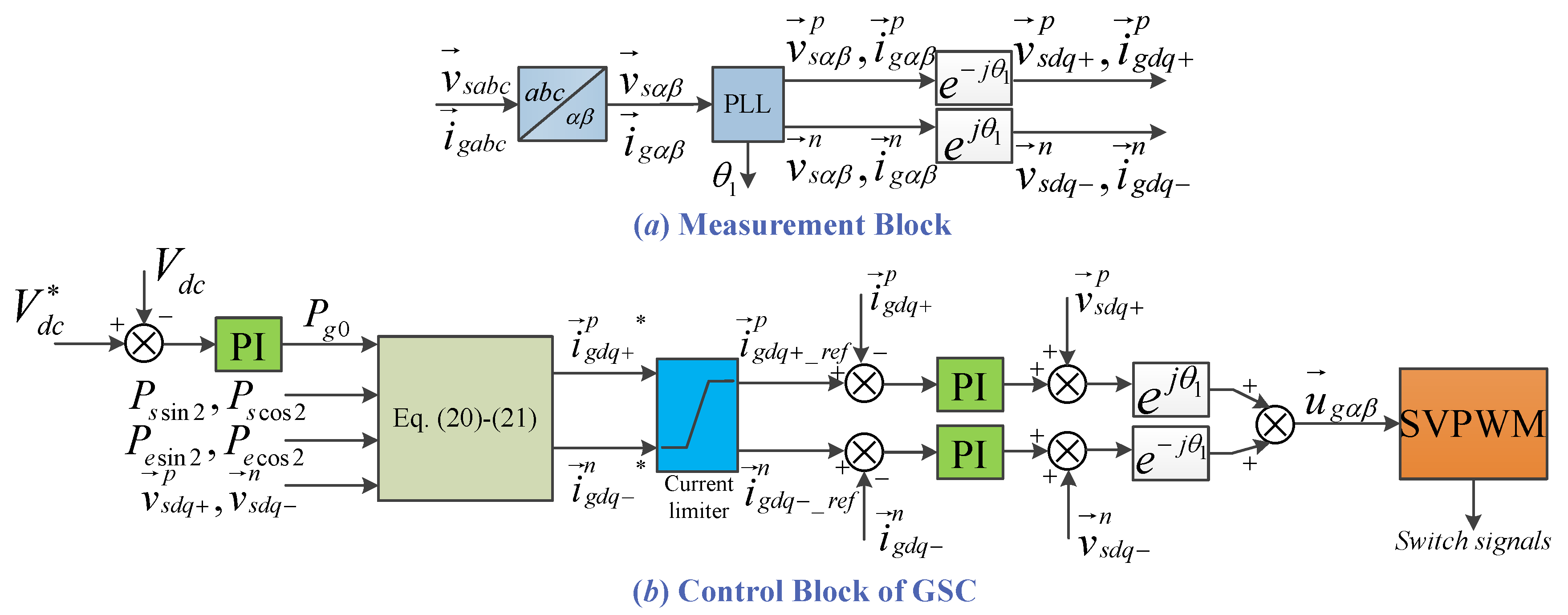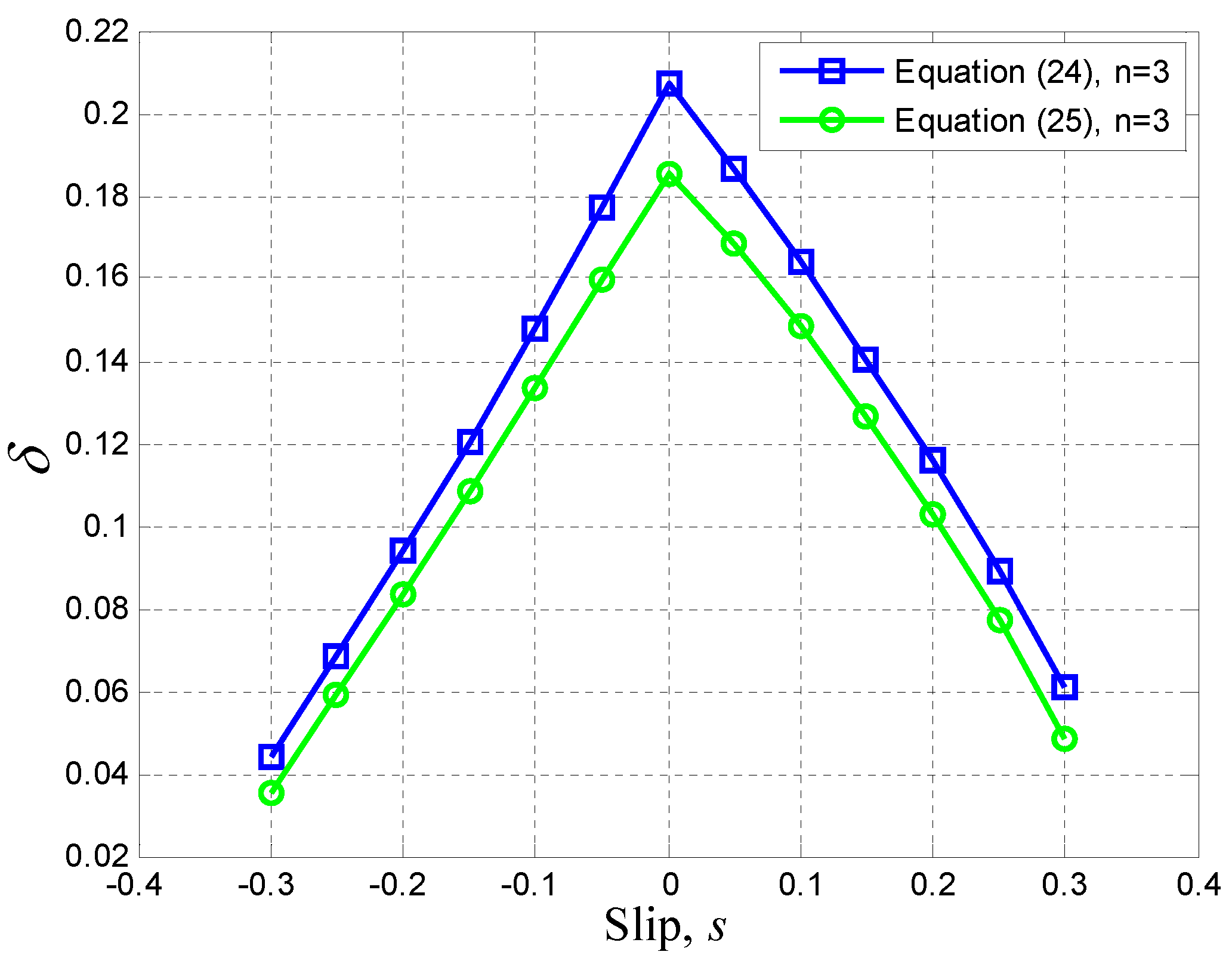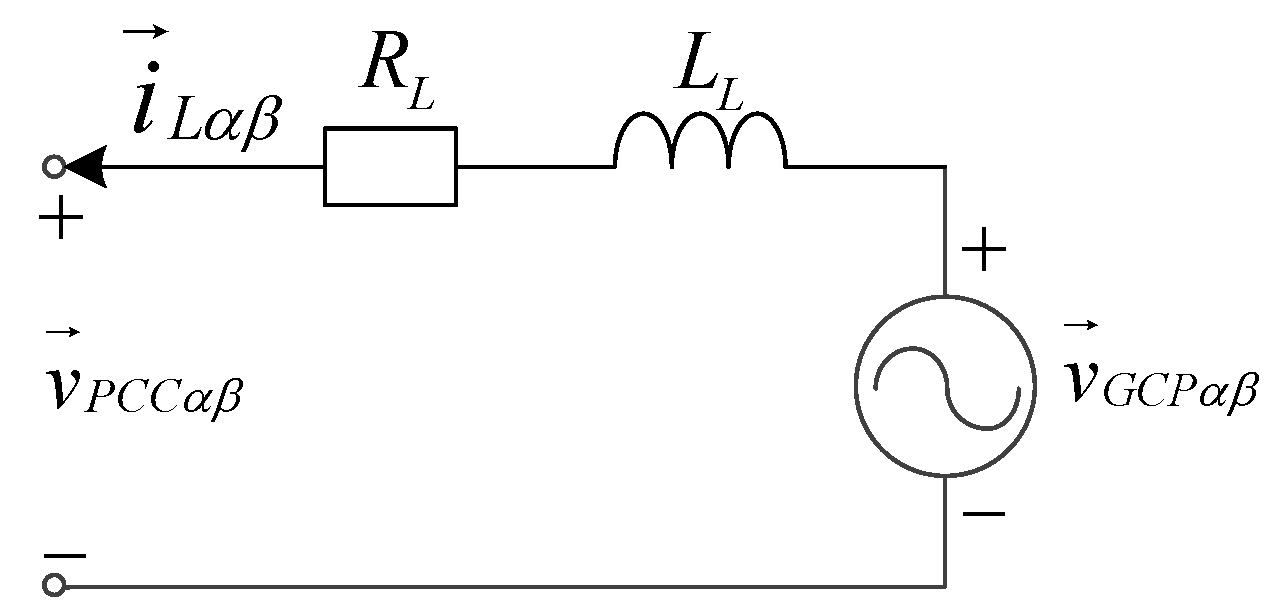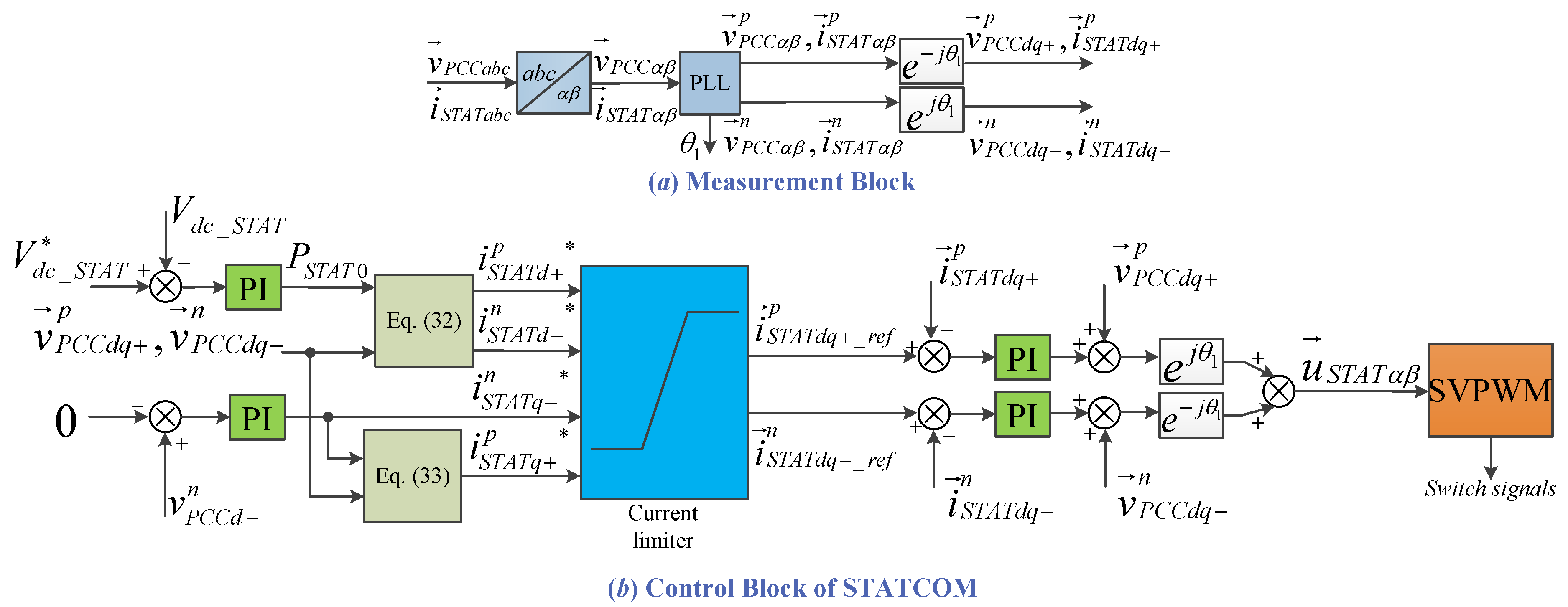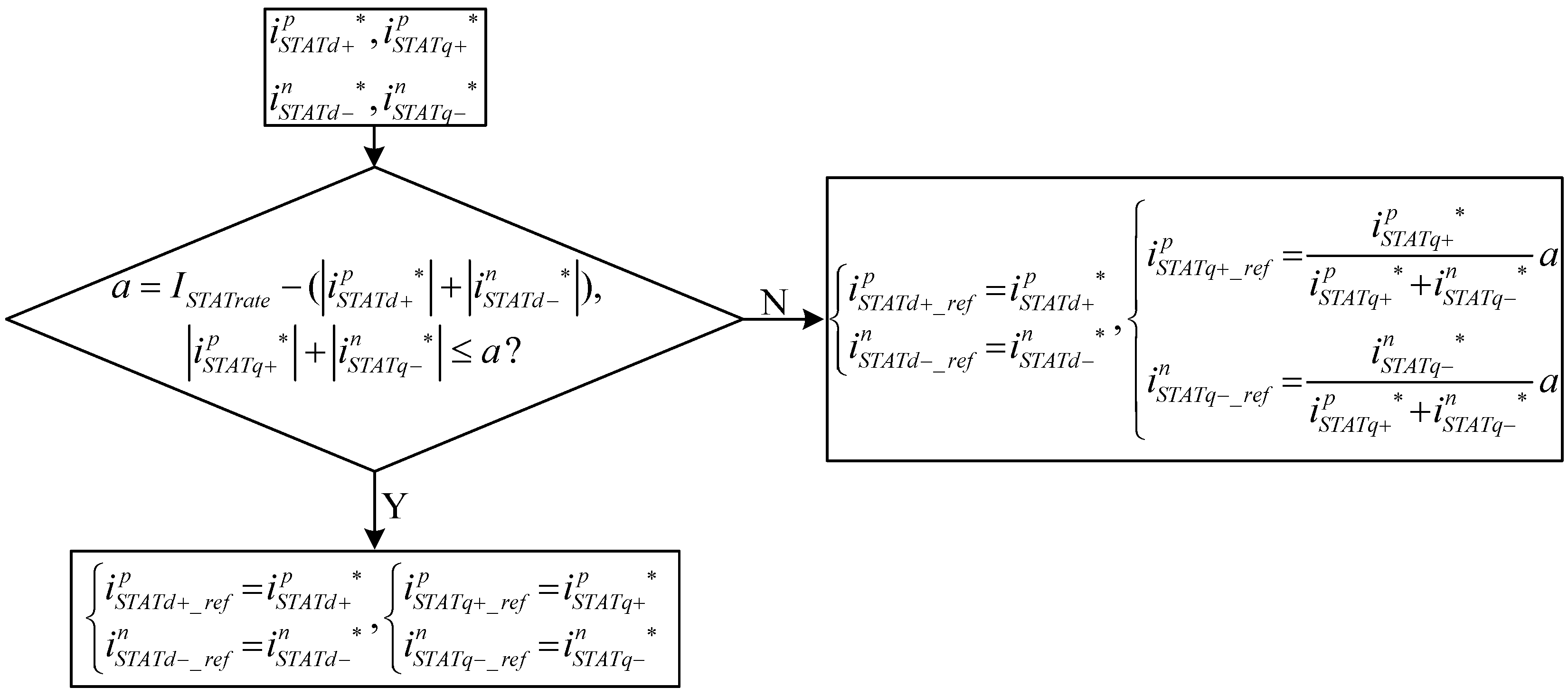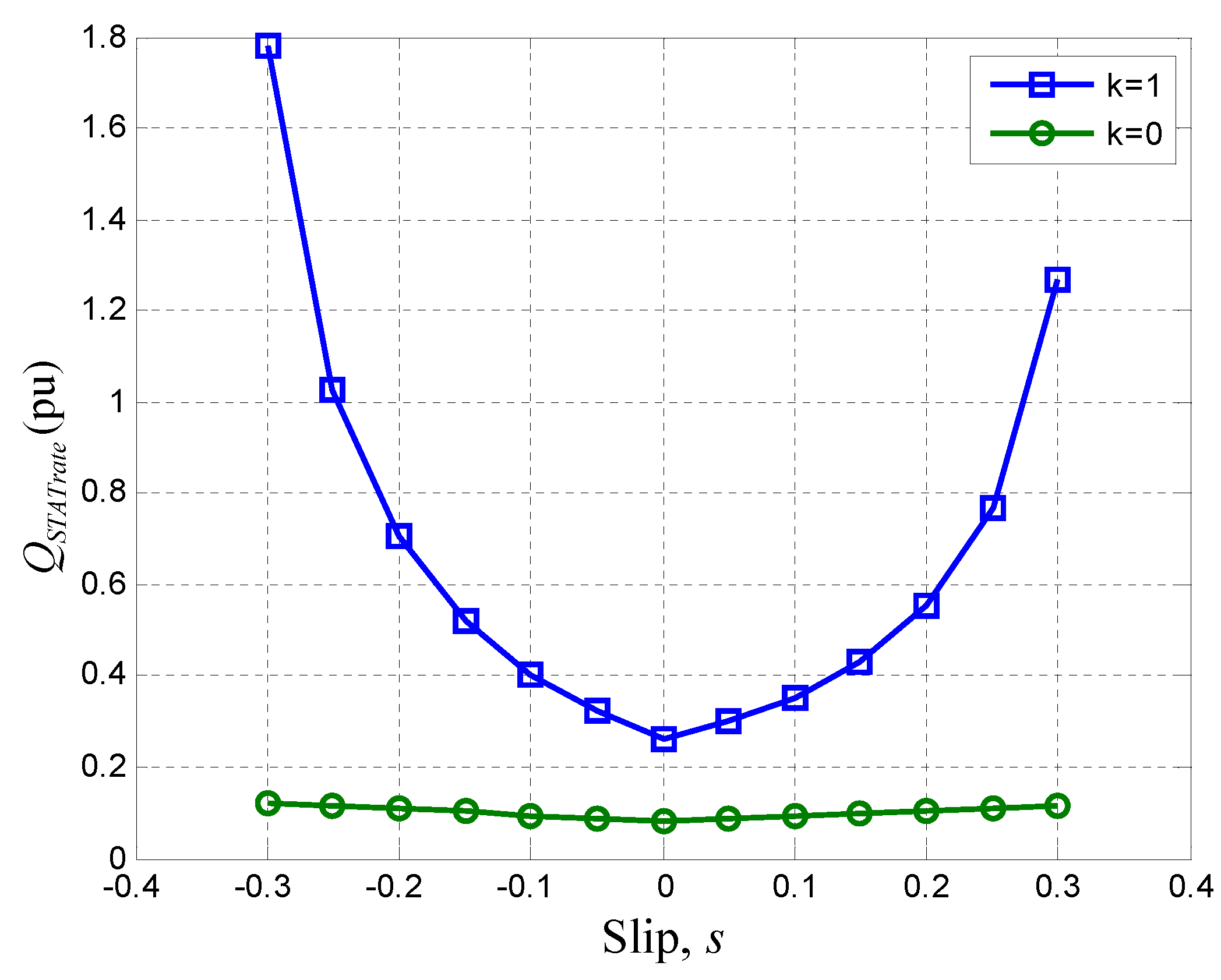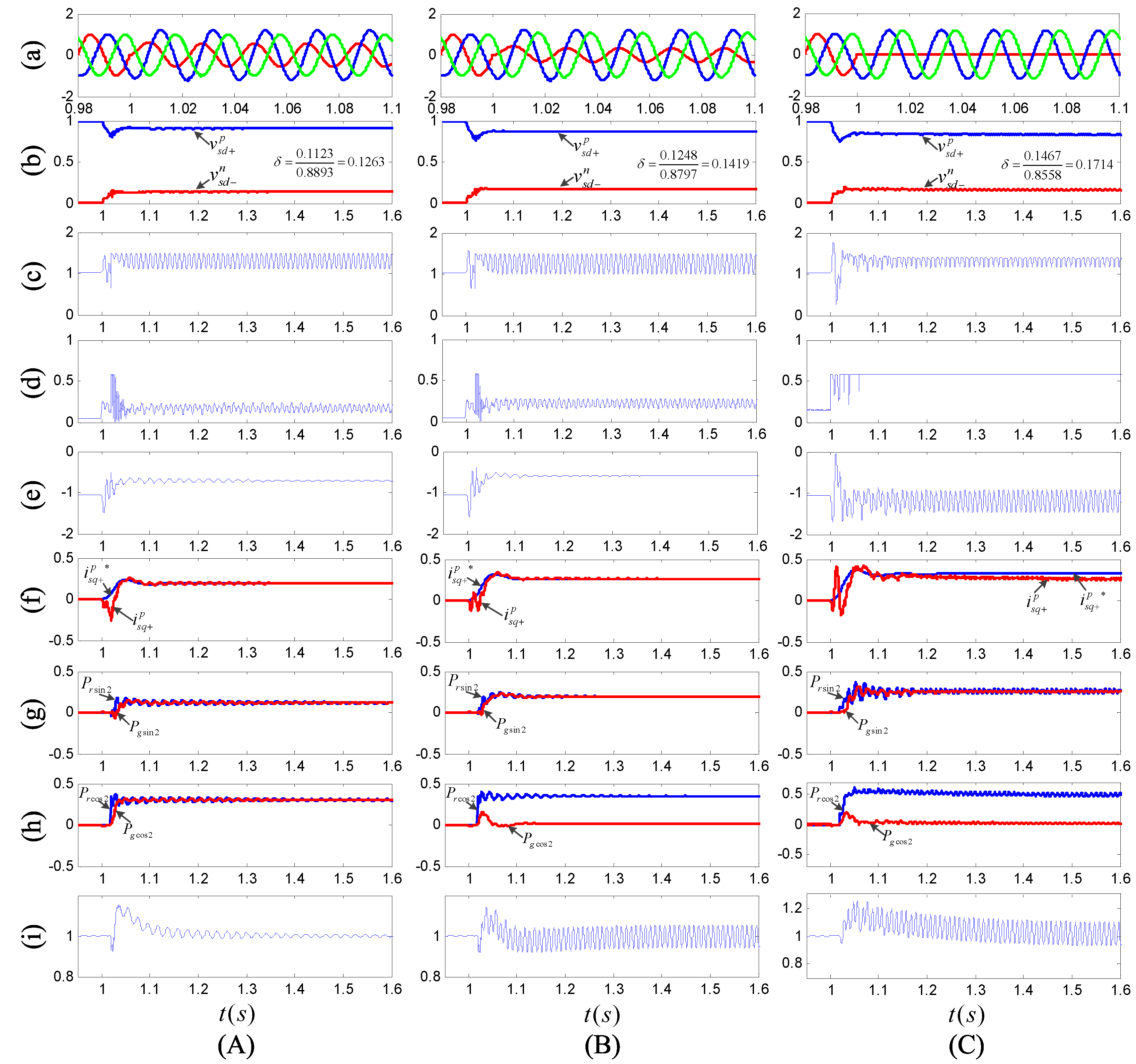1. Introduction
With the increasing penetration of wind power energy in the power system, the capability of low voltage ride-through (LVRT) is becoming a requirement for grid-connected wind farms in the grid codes of more countries to ensure the reliable operation of the power system during grid faults [
1,
2,
3]. More specifically, the wind generation systems need to remain connected to the power grid during grid faults, while providing effective voltage support as the conventional generation systems. Among the different types of wind energy conversion systems (WECSs), a wind turbine with doubly-fed induction generator (DFIG) is used most commonly in commercial MW-class wind generation systems, since the needed capacity of its converter is only 25%–30% of the system rated power [
4]. However, DFIG-based WECS is very sensitive to grid disturbances; a sudden grid voltage dip may even destroy its converters [
5,
6,
7]. Generally, the whole LVRT process for DFIG-based WECS can be divided into three continuous periods according to the LVRT grid codes [
8], the initial period after the grid fault occurs (the first period), the low voltage-sustaining period (the second period) and the grid voltage recovery period after fault clearance (the third period). To achieve complete LVRT, the control objectives for DFIG-based WECS in each period are different.
In the initial period after a grid fault occurs, a large electromotive force (EMF) is induced in the rotor circuit of the DFIG by the transient decay component of the stator flux, which results from the stator voltage dip [
5,
6,
7]. To ensure the safe operation of the rotor-side converter (RSC), the control objective for DFIG-based WECS in this period is to restrain the rotor surge current caused by the large EMF [
8]. The corresponding control schemes have been investigated thoroughly in references [
5,
9,
10,
11,
12,
13,
14]. The rotor crowbar protection is a simple but effective measure, which is commonly used at present [
15,
16]. When a grid fault occurs, the active crowbar is triggered to short the rotor circuit of the DFIG, which can accelerate the decay of the transient stator flux while protecting the RSC [
17,
18]. The previous studies for the first period of the DFIG’s LVRT are comprehensive; therefore, this paper will focus on the second period.
When the transient stator flux is almost damped out, it enters the low voltage-sustaining period. The crowbar is cut off, and the RSC recovers the control of the DFIG. The control objective for DFIG-based WECS in this period is to support the grid voltage by injecting reactive current into the network [
8]. For symmetrical grid faults, the conventional vector control scheme can be applied here with the reactive current reference set to follow the LVRT grid codes [
19]. However, the control issue becomes more complicated during asymmetrical grid faults.
Under asymmetrical grid fault conditions, the imbalance in the grid voltage has negative impacts on the operation of the DFIG and the grid stability. Specifically, the existence of negative-sequence voltage brings double grid frequency oscillations on the active and reactive powers, as well as on the electromagnetic torque [
20,
21]. To eliminate such oscillations, several control schemes with sequence decomposition and advanced algorithms have been proposed to address small voltage imbalance conditions [
22,
23,
24,
25,
26,
27,
28]. In addition, the impact of the limited converter rating on the control of DFIG-based WECS is analyzed in references [
8,
29]. Furthermore, the detailed power generation capability and feasibility regions of the DFIG with limited RSC rating considered are derived in reference [
30]. Consequently, for severe asymmetrical fault situations, the control targets proposed in references [
22,
23,
24,
25,
26,
27,
28] can hardly be achieved due to the converter capacity limitation.
The previous studies on the second period of the asymmetrical LVRT mainly focus on keeping the DFIG-based WECS connected to the power grid with safe operation. However, the reactive support requirement of the LVRT grid code during asymmetrical grid faults is already under discussion in some countries. For example, as indicated in the German ordinance “SDLWindV”, at least a 2% rated positive-sequence reactive current per percent positive-sequence voltage drop should be supplied by the WECS when the positive-sequence voltage drop is more than 10% [
3]. Therefore, the grid voltage support requirement should be considered in the control scheme design of DFIG-based WECS.
As mentioned above, the effects of the control schemes in the second LVRT period are limited by the converter capacity of the DFIG-based WECS when the grid fault is severe. To improve the LVRT capability of a wind farm containing amounts of DFIG-based WECSs, the wind farm can be equipped with some extra equipment to alleviate the voltage dip situations. Since the static synchronous compensator (STATCOM) supports the voltage at the point of common coupling (PCC) by injecting reactive current into the network, it is more suitable for a Chinese wind farm integrated into a weak power grid with long transmission lines [
31]. The control strategy of STATCOM during LVRT is reported in references [
32,
33,
34]; however, these studies focus on verifying the effectiveness of STATCOM under symmetrical grid fault conditions. For asymmetrical grid faults, some critical problems lack theoretical analyses, such as the necessity for a STATCOM, the control strategy and the capacity matching method for the STATCOM, if it is needed.
Consequently, for the second period of an asymmetrical LVRT, there is a need for a viable solution for the DFIG-based wind farm to meet the reactive support requirement of the LVRT grid code with safe grid-connected operation.
Within that framework, this paper has been organized as follows. In
Section 2, after reviewing the DFIG and grid-side converter (GSC) modeling under unbalanced grid voltage conditions, the control schemes for RSC and GSC in the second period of an asymmetrical LVRT are designed, taking the LVRT grid code into consideration. Then, the controllability analysis of the whole DFIG-based WECS is formulated as an optimization problem in
Section 3. After solving the optimization problem, the controllable regions represented by the unbalanced degree of grid voltage are given. These results indicate that a DFIG-based WECS can only achieve its control objectives under mild asymmetrical fault situations. In
Section 4, the STATCOM is introduced to ensure that the DFIG-based WECSs in the wind farm remain controllable under severe asymmetrical fault situations. To reduce the unbalanced degree of fault voltage while mitigating the oscillations on the direct current (DC)-link voltage of the STATCOM, a voltage compensation control scheme and corresponding capacity matching method for the STATCOM are proposed.
Section 5 gives the simulation verifications. Finally, the conclusions are summarized in
Section 6.
4. Control Scheme and Capacity Matching of STATCOM
The typical diagram of the power system integrated with a wind farm [
8,
37] is shown in
Figure 5. Wind power is first exported to the medium voltage distribution network at the PCC through a Y/Delta-configured step-up transformer, where the STATCOM is located to dynamically adjust the PCC voltage. Afterwards, via a long transmission line, wind power is integrated into the power grid at the grid connection point (GCP) through another Delta/Y-configured step-up transformer, at the medium voltage side of which a grounding transformer is employed for short-circuit protection.
Figure 5.
A grid-connected DFIG-based wind farm equipped with a static synchronous compensator (STATCOM).
Figure 5.
A grid-connected DFIG-based wind farm equipped with a static synchronous compensator (STATCOM).
The equivalent circuit of the power system transmission network in
Figure 5 can be given as
Figure 6 [
40], and the voltage equation in the stationary reference frame,
, can be expressed as:
where
,
and
are the space vectors of GCP voltage, PCC voltage and transmission current, respectively;
and
are the equivalent resistance and inductance of the transmission network.
Figure 6.
Equivalent circuit of the power system transmission network.
Figure 6.
Equivalent circuit of the power system transmission network.
Since the resistive voltage drop can be neglected on the long transmission line [
40] under the steady-state in the positive- and negative-sequence
orientation, Equation (
26) can be simplified to:
It is clear from Equation (
27) that the positive- and negative-sequence components of PCC voltage can be controlled by correctly injecting positive- and negative-sequence reactive currents, respectively. Therefore, under severe asymmetrical fault situations, STATCOM can reduce the unbalanced degree of PCC voltage into the controllable regions of DFIG-based WECS by means of reactive current injection.
Similar to the GSC, the instantaneous active and reactive powers from STATCOM to the grid can be expressed as:
where:
The DC-link voltage of STATCOM is:
where:
It can be seen from Equations (
28)–(
31) that the unbalanced PCC voltage can also bring double grid frequency oscillations on the DC-link voltage of STATCOM. As a result, the positive- and negative-sequence STATCOM current references should be set as follows to mitigate its DC-link voltage fluctuations:
where
is given by the output of the DC-link voltage regulator;
is given by the output of the negative-sequence PCC voltage regulator; and
k determines the oscillation magnitude on the DC-link voltage of STATCOM,
i.e., the larger
k is, the smaller the oscillation is.
The control diagram of STATCOM is shown in
Figure 7. The control priority of STATCOM is implemented by designing the current limiter in
Figure 7b. Specifically, the control of active currents has a higher priority than that of the reactive currents, as shown in
Figure 8.
Figure 7.
Voltage compensation control scheme of STATCOM.
Figure 7.
Voltage compensation control scheme of STATCOM.
Figure 8.
Calculation algorithm for the STATCOM current references.
Figure 8.
Calculation algorithm for the STATCOM current references.
Neglecting the internal power dissipation of STATCOM, there is under the steady-state; thus the current capacity of STATCOM is mainly used to compensate for the imbalance of the PCC voltage. Since the STATCOM aims to reduce the unbalanced degree of PCC voltage into the controllable regions of DFIG-based WECS under severe asymmetrical fault situations, it is necessary to confirm the minimum capacity required for the STATCOM.
Suppose that the unbalanced degree of PCC voltage before compensation is:
where the
is given by solving Equation (
25).
To ensure the DFIG-based WECS stay controllable, the voltage compensation target of STATCOM should be set as:
Combining Equation (
33), the capacity minimization problem of STATCOM can be formulated as a nonlinear programming problem, as in Equation (
36):
The calculated results of the above problem is:
where
is the PCC voltage magnitude before gird faults.
From Equation (
38), it is easy to find out that the minimum capacity required for the STATCOM increases monotonically with
k. As a result, how to choose
k comes to be a trade-off between mitigating oscillations on the DC-link voltage of STATCOM and reducing the needed capacity of STATCOM. Consequently, in engineering applications,
k can be selected according to the tolerated maximum voltage fluctuation of the DC-link capacitor.
A numerical example is given for Equation (
38) as follows. According to
Figure 5, with the
[Equation (
25),
] given in
Table 3 and (
,
,
mH/km), the needed capacity of STATCOM with various
k is the area above its corresponding line in
Figure 9, and the
is given in
Table 4 (capacity base value is 9 Mvar).
Figure 9.
Capacity matching of STATCOM through DFIG’s operative slip range.
Figure 9.
Capacity matching of STATCOM through DFIG’s operative slip range.
Table 4.
Minimum capacity required for the STATCOM with different slips.
Table 4.
Minimum capacity required for the STATCOM with different slips.
| Slip s | −0.3 | −0.2 | −0.1 | 0 | 0.1 | 0.2 | 0.3 |
|---|
| (pu) () | 0.1208 | 0.1083 | 0.0952 | 0.0818 | 0.0914 | 0.1032 | 0.1173 |
| (pu) () | 1.7816 | 0.7042 | 0.4036 | 0.2614 | 0.3533 | 0.5537 | 1.2684 |
5. Simulation Verifications
The simulations are intended to verify the effectiveness of the proposed control schemes for DFIG-based WECS and STATCOM during asymmetrical grid faults, as well as the accuracy of the DFIG-based WECS’s controllable regions derived in
Section 3 and the STATCOM’s capacity matching method derived in
Section 4.
The typical diagram of the power system integrated with the wind farm presented in
Figure 5 is implemented by MATLAB/SIMULINK. The wind farm is simulated as a lumped 9 MW DFIG model containing six DFIGs, each rated at 1.5 MW. The parameters of the single DFIG system follow
Table 1 and
Table 2. Initially, the DFIG is under vector control in super-synchronous operation (
), while the stator output active power is 1 pu with the unity power factor. The grid fault occurs at the GCP when
s. After that, the insulated gate bipolar transistors (IGBTs) of RSC are blocked, and the rotor crowbar is used to ride-through the first period of LVRT, which lasts 20 ms, according to the German grid code [
2,
3]; after
s, it enters the second period of LVRT, the crowbar is cut off and RSC recovers the control of DFIG. In this simulation, the STATCOM is modeled as a gate turn-off thyristor (GTO) pulse-width modulation (PWM) converter with a DC-link capacitor. Since the whole simulation model contains many modules, the RSC, GSC and STATCOM are all implemented by their mathematical models instead of their circuit-based models, so as to achieve fast simulations. It needs to be noted that the simulations are realized under the following assumptions:
(i) Assuming that the crowbar is triggered once the grid voltage drop occurs, since the interval between the occurrence of the grid voltage drop and the crowbar cut-in is just a few milliseconds.
(ii) Assuming that the DFIG speed does not change during the grid faults, since the inertia of a MW-class wind turbine is very large and the time duration of the grid faults is very short.
Two different scenarios are examined in this section:
(i) Case 1: the proposed control schemes for RSC and GSC shown in
Figure 1 and
Figure 2 are employed to control the DFIG-based wind farm in the second period of LVRT without STATCOM compensation. The simulation results in three situations are shown in
Figure 10, and the following conclusions can be drawn from this figure.
Figure 10.
Simulation results of the DFIG-based wind farm without STATCOM compensation during asymmetrical grid faults: (a) three-phase voltages at GCP (pu); (b) magnitudes of positive- and negative-sequence stator voltages (pu); (c) magnitude of rotor current space vector (pu); (d) magnitude of rotor voltage space vector (pu); (e) electromagnetic torque (pu); (f) positive-sequence stator reactive current (pu); (g) and (h): magnitudes of active power oscillations on both sides of the DFIG system’s DC-bus (pu); and (i) the DC-link voltage of DFIG system (pu). (A) single-phase resistance-grounded fault (grounding resistance ); (B) single-phase resistance-grounded fault (grounding resistance ); and (C) single-phase solidly-grounded fault.
Figure 10.
Simulation results of the DFIG-based wind farm without STATCOM compensation during asymmetrical grid faults: (a) three-phase voltages at GCP (pu); (b) magnitudes of positive- and negative-sequence stator voltages (pu); (c) magnitude of rotor current space vector (pu); (d) magnitude of rotor voltage space vector (pu); (e) electromagnetic torque (pu); (f) positive-sequence stator reactive current (pu); (g) and (h): magnitudes of active power oscillations on both sides of the DFIG system’s DC-bus (pu); and (i) the DC-link voltage of DFIG system (pu). (A) single-phase resistance-grounded fault (grounding resistance ); (B) single-phase resistance-grounded fault (grounding resistance ); and (C) single-phase solidly-grounded fault.
(1) It can be seen from
Figure 10c that, in the first period of LVRT (1 s∼
s), the rotor transient surge current can be restrained below 2 pu with the help of a rotor crowbar, which achieves the safe operation of the converter in this period.
(2) In situation (A), since the unbalanced degree of the stator voltage (
Figure 10A:b) is within the derived controllable region of DFIG-based WECS according to
Table 3,
i.e.,
[Equation (
25),
,
], the control targets of both RSC and GSC can be achieved. Specifically, the oscillations on the electromagnetic torque can be eliminated (
Figure 10A:e), the positive-sequence stator reactive current can meet the LVRT grid code requirement (
Figure 10A:f) and there are no oscillations on the DC-link voltage of the DFIG system (
Figure 10A:i).
(3) When the grid fault becomes more severe as in situation (B), there is
[Equation (
25),
,
]
[Equation (
24),
,
], which means that the control target of GSC can no longer be achieved, but the DFIG is still controllable. As a result, the GSC has no sufficient current capacity to transfer the rotor-side active power oscillations to the grid (
Figure 10B:h), which results in the oscillations on the DC-link voltage of the DFIG system (
Figure 10B:i).
(4) Furthermore, when
[Equation (
24),
,
] as in situation (C), even the DFIG becomes uncontrollable. As a result, the output voltage of RSC (
Figure 10C:d) presents over-modulation, which results in the oscillations on electromagnetic torque (
Figure 10C:e) and the non-compliance of the positive-sequence stator reactive current (
Figure 10C:f).
Consequently, the above simulation results can validate the accuracy of the DFIG-based WECS’s controllable regions derived in
Section 3 and the effectiveness of the proposed control scheme for DFIG-based WECS within its controllable regions.
(ii) Case 2: the proposed control scheme shown in
Figure 7 is employed to control the STATCOM for the purpose of improving the asymmetrical LVRT capability of the DFIG-based wind farm. The simulation results in three situations are shown in
Figure 11, and the following conclusions can be drawn from this figure.
(1) Comparing
Figure 11A with
Figure 10C, it can be seen that, with the help of voltage compensation supplied by a STATCOM having sufficient capacity,
i.e.,
pu
pu (
) according to
Table 4, the unbalanced degree of the stator voltage can be reduced from 0.1714 to 0.1011. This means that the DFIG-based WECS gets into its controllable regions [
(Equation (
25),
,
)]. Therefore, the control targets of both RSC and GSC can be achieved again in this situation. However, since all the current capacity of STATCOM is used to compensate for the negative-sequence PCC voltage (
Figure 11A:k–l), it may cause large oscillations on the DC-link voltage of STATCOM (
Figure 11A:m).
Figure 11.
Simulation results of the DFIG-based wind farm with STATCOM compensation during asymmetrical grid faults: (a) three-phase voltages at GCP (pu); (b) magnitudes of positive- and negative-sequence stator voltages (pu); (c) magnitude of rotor current space vector (pu); (d) magnitude of rotor voltage space vector (pu); (e) electromagnetic torque (pu); (f) positive-sequence stator reactive current (pu); (g) and (h): magnitudes of active power oscillations on both sides of the DFIG system’s DC-bus (pu); (i) DC-link voltage of DFIG system (pu); (j) magnitude of STATCOM current space vector (pu); (k) positive-sequence components of STATCOM current (pu); (l) negative-sequence components of STATCOM current (pu); and (m) the DC-link voltage of STATCOM (pu). (A) single-phase solidly-grounded fault ( pu, ); (B) single-phase solidly-grounded fault ( pu, ); and (C) single-phase solidly-grounded fault ( pu, ).
Figure 11.
Simulation results of the DFIG-based wind farm with STATCOM compensation during asymmetrical grid faults: (a) three-phase voltages at GCP (pu); (b) magnitudes of positive- and negative-sequence stator voltages (pu); (c) magnitude of rotor current space vector (pu); (d) magnitude of rotor voltage space vector (pu); (e) electromagnetic torque (pu); (f) positive-sequence stator reactive current (pu); (g) and (h): magnitudes of active power oscillations on both sides of the DFIG system’s DC-bus (pu); (i) DC-link voltage of DFIG system (pu); (j) magnitude of STATCOM current space vector (pu); (k) positive-sequence components of STATCOM current (pu); (l) negative-sequence components of STATCOM current (pu); and (m) the DC-link voltage of STATCOM (pu). (A) single-phase solidly-grounded fault ( pu, ); (B) single-phase solidly-grounded fault ( pu, ); and (C) single-phase solidly-grounded fault ( pu, ).
![Energies 06 04660 g011]()
(2) Comparing
Figure 11B with
Figure 11A, as the capacity of STATCOM (0.1 pu) is assigned between its positive- and negative-sequence reactive currents following Equation (
33) in which
(
Figure 11B:k–l), the oscillations on the DC-link voltage of STATCOM can be eliminated (
Figure 11B:m). However, for
, it needs a STATCOM rated at least 0.4036 pu to ensure that the DFIG-based wind farm stays controllable according to
Table 4. As a result, a STATCOM rated at 0.1 pu is insufficient to reduce the unbalanced degree of stator voltage into its controllable regions [
(Equation (
24),
,
)]; thus the control targets of both RSC and GSC can no longer be achieved in this situation.
(3) Furthermore, comparing
Figure 11C with
Figure 11B, the capacity of STATCOM is increased to 0.42 pu, which is larger than 0.4036 pu. As a result, the STATCOM is sufficient to reduce the unbalanced degree of the stator voltage into the controllable region of DFIG-based WECS [
(Equation (
25),
,
)], while eliminating the oscillations on the DC-link voltage itself. Thus, in this situation, the control targets of both RSC and GSC can be achieved again.
Consequently, the above simulation results can validate the effectiveness of the proposed control scheme for STATCOM during asymmetrical LVRT and the accuracy of the corresponding capacity matching method derived in
Section 4.
6. Conclusions
This paper has discussed the coordinated control of a DFIG-based wind farm and a STATCOM for LVRT grid code compliance during asymmetrical grid faults. Simulations on a 9 MW DFIG-based wind farm are performed to validate the proposed control strategy. As a result, the following conclusions can be drawn:
(1) The control scheme for a DFIG-based WECS is designed by taking the LVRT grid code into consideration; the controllability of a DFIG-based WECS with the proposed control scheme is analyzed by means of the optimal method. The derived controllable regions indicate that a DFIG-based WECS can only remain controllable under mild asymmetrical fault situations, and the GSC rating is the primary explanation for this limitation.
(2) A STATCOM is introduced as assistive equipment to ensure that the DFIG-based wind farm remains controllable under severe asymmetrical fault situations. To reduce the unbalanced degree of fault voltage while mitigating the oscillations on the DC-link voltage of the STATCOM, a voltage compensation control scheme for the STATCOM is designed. In addition, the capacity matching method of the STATCOM is given, which indicates that a trade-off exists between mitigating the oscillations on the DC-link voltage of the STATCOM and reducing the needed capacity of the STATCOM.
The proposed coordinated control strategy can guarantee that a DFIG-based wind farm will supply the positive-sequence reactive current defined by the LVRT grid code with safe grid-connected operation. This improves the reliability of both the wind farm and the power system during grid faults. Moreover, the outcome of the analysis in this paper may also be interesting for evaluating the asymmetrical LVRT capability of DFIG-based WECS and for designing extra assistive equipment for the LVRT of a DFIG-based wind farm.
